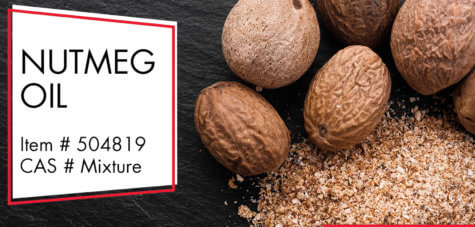Nutmeg Oil
Item#: 504819 CAS: Mixture FEMA: 2793
Odor Strength: Medium
Odor Description: Woody, powdery, spicy, pine, resinous
Taste Description: Sweet, woody, spicy, aromatic, terpenic, nutmeg
As the temperature drops and the leaves start to turn, Americans move warm spices to the front of their cabinets in preparation to cook seasonal dishes like pumpkin pie, spiced confectioneries, and warm apple pie. One such spice is nutmeg. While it is known as a quintessential holiday aroma, nutmeg is also widely used in fragrance formulations. Nutmeg oil is a key note in Dior Farhenheit and Guerlain Vetiver Sport, and a classic ingredient in winter candles.
Nutmeg is the fruit of the myristica fragrans tree, which is native to Indonesia. The tree thrives in tropical climates, and is also grown in India or the West Indies. The spice is typically harvested between June and August, but the true indicator of ripeness is when the pericarp of the fruit splits open. The fruit is harvested by hand (picked off the tree or collected off the ground). Nutmeg fruit looks like a bit like a yellow peach; inside and out. Once harvested, it is split open to reveal its seed. Then, the nutmeg is separated into rind, fruit, nut, and mace.
After harvest, the nut and mace are washed, and allowed to air-dry. Commercial mechanical drying is preferred, because it eliminates factors that can compromise the quality of the spice such as exposure to sunlight, contaminants, or pests. Drying is the most critical step; and is especially time consuming since nutmeg’s harvest falls during monsoon season.
Nutmeg contains both volatile and non-volatile oil. The nuts are first hydraulically pressed to express the non volatile oil. Then, the ground nutmeg seeds are exposed to a classic steam distillation process by pressurized steam. The steam allows naturally-occurring volatile aroma compounds to evaporate with it. The aromatic steam is then condensed to water, and the nutmeg oil is skimmed off the top. Nutmeg oil is rich is alpha & beta pinene, sabinene, myristicin, limonene, and various terpenes. Myrisiticin levels tend to be higher in Indonesian oil, and lower in Indian material.
Flavorists formulate nutmeg oil (usually a terpeneless version) as a component in savory sauces and seasoning combinations for meats and poultry. It is also an ingredient used in most commercial ketchup flavors. Most notably, nutmeg oil is a key ingredient in cola flavors.
Perfumers use nutmeg oil in chypre and oriental formulations. The extract possesses a heady top, spicy-sweet heart and tenacious base note. It is found in the earthy, woody masculines, like Azzaro’s Visit. Notorious accords include lavender, oakmoss, cinnamon, and Peru balsam.
Nutmeg oil has notable aromatherapy virtues. It can be used as a warming massage oil, a remedy for nausea, an aid for digestion, and give relief to achy joints.
If you are interested in seeing a sample or placing an order, please email Nicholas Bourne at nbourne@vigon.com or call 570-422-6026.

